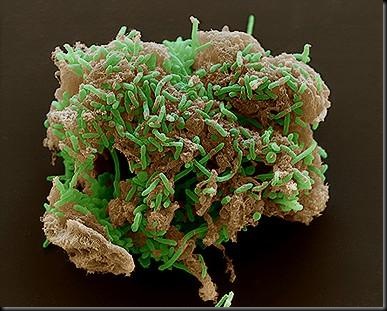They breathe rust, clean up polluted groundwater, generate electricity, and may harbor clues to the origins of life. That's a lot for one family of microscopic bugs, but don't be surprised when Derek Lovley wows the world with another wonder from the Geobacter genus of bacteria.
"When we think we have hit the last of the big discoveries, something else comes along," said Lovley, a microbiologist at the University of Massachusetts, Amherst.
The microbes' metabolism is unique: They use metals to get energy from food in the same way humans use oxygen. In 1987 Lovley discovered Geobacter metallreducens in some iron-rich mud he scooped up from the Potomac River.
In the 17 years since that discovery, Lovley and his colleagues have found more than 30 species in the bug family, sequenced the genomes of several, and filled scientific journals with the details of new insights.
Lovley collaborates with scientists around the world, and his lab buzzes with more than 50 researchers. Most recently, Lovley and his colleagues sequenced the genome of a Geobacter species that can generate electricity and cleanup groundwater contaminated with uranium.
"Never underestimate the abilities of the microbial world," said Tim Magnuson, a microbiologist who worked in Lovley's lab before moving to Idaho State University in Pocatello.
Magnuson believes that the Geobacter species and a number of other metal-reducing bacteria discovered since Lovley's seminal 1987 find are the just the beginning of what promises to be an exciting scientific journey into the world or microbes with unique metabolisms.
"The more we look, the more we discover. We have and will discover organisms that are not at all related to Geobacter but can carry out that kind of metabolism. It is a huge frontier."
Lovley Bugs
When Lovley embarked on his academic journey into the sciences, all he wanted to find was a good job in the outdoors. But as he pondered what made the world go around as an undergraduate biology major at the University of Connecticut in the 1970s, things began to change.
"It started to be apparent that these microorganisms account for a lot of biomass [living matter] on Earth and are big drivers for the environmental and ecological processes," Lovley said. "So I went to grad school and tried to learn microbiology."
After receiving his Ph.D. from Michigan State University in 1982, Lovley took a job with the United States Geological Survey studying how microorganisms affected groundwater in the Chesapeake Bay.
He knew that microorganisms could live in oxygen-deprived environments by processing things such as sulfate and methane. If they could do that, Lovely reasoned, they might also be able to make a living from iron. Which is why, in 1987, Lovely scooped up the iron-rich mud from the Potomac River just downstream from Washington, D.C. Unbeknownst to him, the microbes therein would change his life.
Back in his lab, Lovley put the mud in a test tube, added some acetate—essentially vinegar, a favorite microbe food—and watched. Eventually, he noticed little black minerals collecting on the bottom of the tube amidst a sea of fluffy orange iron oxide, or rust.
"I put a magnet up to the side of the tube, and all the little pieces flew over to the side of the glass," Lovely said. "That was a 'Eureka!' moment."
The mud-dwelling microbes, which Lovley later named Geobacter metallreducens, obtained their energy by transferring electrons onto the rust. In the process, they turned the rust into magnetite.
Magnetite is the source of most of the magnetic material deposited on Earth some two billion years ago. Lovley and his colleagues concluded in a 1987 paper published in Nature that the microbes may have been responsible for most of these early magnetite deposits.
Microbes in Action
Since Geobacter metallreducens was discovered, Lovley and his colleagues have tried to figure out how to take advantage of this unique microbial metabolism, from cleaning up contaminated groundwater to generating electricity.
Magnuson, the Idaho State University microbiologist, believes that the ability of microorganisms like Geobacter to clean up groundwater may be of particular use to humans in the coming decades, as world populations are predicted to experience a water crisis.
He envisions using microbes not only to decontaminate water supplies but to protect them until human consumption.
"Using Geobacter to protect and maintain the quality of these aquifers might be a viable solution, seeing as we are going to run into water-quality issues," he said.
Lovley and his colleagues are not yet developing Magnuson's proposed superefficient water filters, but they are actively developing a method to remove uranium from billions of gallons of contaminated groundwater.
Source:National geographic


No comments:
Post a Comment